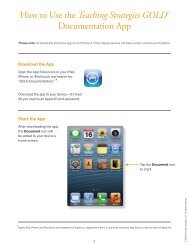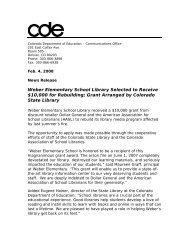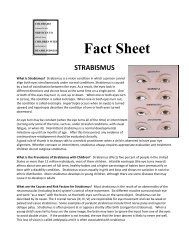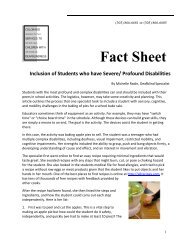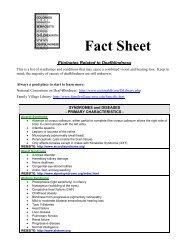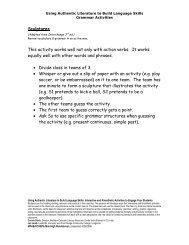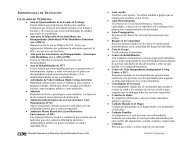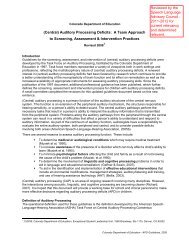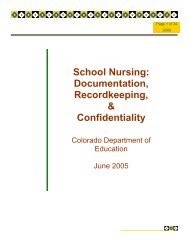ONLINE EDUCATION INTERIM REPORT - Colorado Department of ...
ONLINE EDUCATION INTERIM REPORT - Colorado Department of ...
ONLINE EDUCATION INTERIM REPORT - Colorado Department of ...
You also want an ePaper? Increase the reach of your titles
YUMPU automatically turns print PDFs into web optimized ePapers that Google loves.
8<br />
Act consider reduced lunch-eligible students,<br />
and more recently the Act has included English<br />
language learners as a smaller component for<br />
determining the number <strong>of</strong> “at-risk” students.<br />
Still, other sections <strong>of</strong> state law consider broader<br />
meanings <strong>of</strong> an “at-risk” student. The <strong>Colorado</strong><br />
Preschool and Kindergarten Program (CPKP)<br />
lists eight “signifi cant family risk” factors, any<br />
three <strong>of</strong> which deem a student eligible. These<br />
factors include: free and reduced lunch eligibility;<br />
homelessness; an abusive adult; drug or alcohol<br />
abuse in the family; parent under age 18 at the<br />
time <strong>of</strong> the child’s birth; a parent or guardian<br />
without completion <strong>of</strong> high school or equivalent;<br />
frequent family residence relocation, and a<br />
child’s poor social skills.<br />
Students that are behind in school are also at<br />
risk <strong>of</strong> failing. For example, students who are<br />
behind their classmates in reading have diffi culty<br />
learning the substantive material presented to<br />
them in text. Defi cits in reading and mathematics<br />
make it harder for students to succeed later on<br />
in science, math, and other courses. As students<br />
grow, it is more diffi cult for school systems to<br />
remediate their educational needs. In high<br />
school, students who earn fewer credits are<br />
unable to graduate on time with their peers<br />
and become more likely to drop out. Students<br />
lacking the skills to comprehend the material<br />
before them or feeling stigmatized by their<br />
James enrolled in the On Line Academy during the semester<br />
break as a mid-year Junior. He was passionate about pursuing<br />
a career as a pr<strong>of</strong>essional dancer, and he could not continue his<br />
stringent training and workout schedule while attending his lo-<br />
cal physical school, which was unable to accommodate his spe-<br />
cial circumstances. James completed his junior year and earned<br />
an additional credit in spring. When he returned in fall, he said<br />
that he wanted to fi nish all his senior work by the end <strong>of</strong> the fall<br />
semester. We counseled with both James and his parents about<br />
the diffi culty <strong>of</strong> such an effort and they fully understood that<br />
he would have to continue through spring semester if he was<br />
unable to successfully complete all the requirements for gradua-<br />
tion. James completed all his work in early January with straight<br />
A’s, and has earned his diploma.<br />
underperformance become bored and alienated,<br />
making it harder for educators to help them<br />
catch up. The task force argues that defi ning<br />
“at-risk” in an academic context has merit, and<br />
increased information about the academic status<br />
and educational outcomes <strong>of</strong> those served by<br />
online programs would be helpful to policymakers.<br />
The state is moving forward with the<br />
implementation <strong>of</strong> longitudinal measures <strong>of</strong><br />
academic performance that refl ect students’<br />
growth toward pr<strong>of</strong>i ciency. These measures<br />
will likely be helpful in both identifying students<br />
that are at risk and evaluating the effi cacy <strong>of</strong><br />
programs that serve them. In the online context,<br />
however, it is also possible that students will<br />
become attracted to online alternatives as their<br />
circumstances change. For example, a student<br />
who had performed well in school previously<br />
may become pregnant and start parenting.<br />
In this case, any change from past academic<br />
performance may not indicate a defi ciency in the<br />
student’s program.<br />
For purposes <strong>of</strong> establishing eligibility parameters<br />
for publicly funded online students, state statute<br />
(CRS 22-33-104.6 (7)) authorizes the State Board<br />
<strong>of</strong> Education to promulgate rules for “students<br />
whose parents or legal guardians remove them<br />
from school for extraordinary reasons and for<br />
students who are habitually disruptive or are<br />
otherwise at risk.” In implementing this statute,<br />
the State Board <strong>of</strong> Education adopted Rule<br />
301-56, which has further defi nitions <strong>of</strong> “atrisk,”<br />
including habitually disruptive, habitually<br />
truant, or expelled from school. This list follows<br />
another list <strong>of</strong> extraordinary reasons for removal<br />
from school, which include teen pregnancy,<br />
teen parents, victim <strong>of</strong> a criminal act, or health<br />
or mental health conditions. The audit addressed<br />
none <strong>of</strong> these “at-risk” defi nitions in comparing<br />
online students’ CSAP scores to statewide averages.<br />
All <strong>of</strong> the factors discussed above can put a<br />
student at risk <strong>of</strong> failing in school. The state<br />
should avoid condensing or choosing a single<br />
defi nition. Our commitment to helping all



